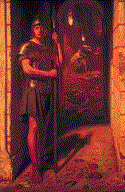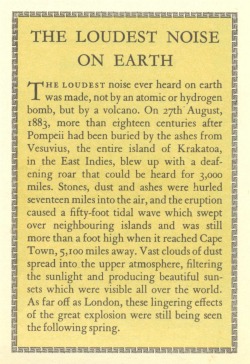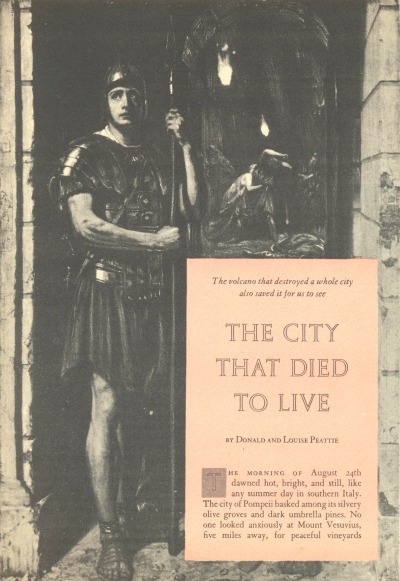|
There are two introductions to Ancient History in the
Reader's Digest Junior Omnibus—a story on the
discovery of the Dead Sea Scrolls, and this one about the
destruction of Pompeii, on the morning of August 24th,
79AD.
The City That Died To Live was first published in the
June 1954 issue of Reader's Digest.
Donald + Louise Peattie
Donald Culross Peattie was born in Chicago in 1898 and
died in Santa Barbara in 1964. Louise Redfield Peattie was
born in 1900 in Glenview, Illinois and died in 1965. They
were best known for their writing on the world of nature,
particularily an area known as the Chicago Wilderness. A
profile of the Peatties is in the Fall 2000 issue of the Chicago
Wilderness Magazine. His best known book was An
Almanac For Moderns (1935) and hers was a novel,
American Acres (1936). Their papers are held in
the special collections of the University of Santa Barbara,
and there is an online listing of the Peatties'
papers.
Edward Poynter
 In the Omnibus itself, the illustration is impressive, taking up a whole page, but it is credited as Reproduced by permission of the Walker Art Gallery, Liverpool with no menti
on of the artist or title of the work. It is
Faithful Unto Death painted by
Edward Poynter in 1865. The title comes from Revelations 2:10, Be faithful unto death, and I will give you the crown of life. The image is from a passage in The Last Days of Pompeii by Edward Bulwer-Lytton: In the Omnibus itself, the illustration is impressive, taking up a whole page, but it is credited as Reproduced by permission of the Walker Art Gallery, Liverpool with no menti
on of the artist or title of the work. It is
Faithful Unto Death painted by
Edward Poynter in 1865. The title comes from Revelations 2:10, Be faithful unto death, and I will give you the crown of life. The image is from a passage in The Last Days of Pompeii by Edward Bulwer-Lytton:
"The air was now still for a few minutes: the lamp from the gate streamed out far and clear: the fugitives hurried on—they gained the gate—they passed by the Roman sentry; the lightning flashed over his livid face and polished helmet, but his stern featur
es were composed even in their awe! He remained erect and motionless at his post. That hour itself had not animated the machine of the ruthless majesty of Rome into the reasoning and self-acting man. There he stood, amidst the crashing elements: he had no
t received the permission to desert his station and escape."
The painting is in the Walker Art Gallery in Liverpool, England.
A big bonus was the side bar about Krakatoa:

|

